skip to main |
skip to sidebar
Events of Wednesday 17th May 2017
I'd never been to Tasmania so, after Melbourne, I'd arranged to tack a couple of days in Hobart on the end of my marathon trip.
Before leaving the Hotel Lindrum on Wednesday morning to fly to Hobart, I'd intended to see a little more of the Melbourne, using train or tram. Although I started to get up when my alarm went off at 6.00 a.m., two things discouraged me from carrying out my planned exploration. Firstly, although I'd slept soundly, I still felt pretty tired - it had been a fairly intensive few weeks and I don't appear to have the stamina I once enjoyed. Secondly, it was raining and miserable outside. So, instead, I just worked in my room on the computer and watched the suburban trains go by, still impressed by the intensity of the service.
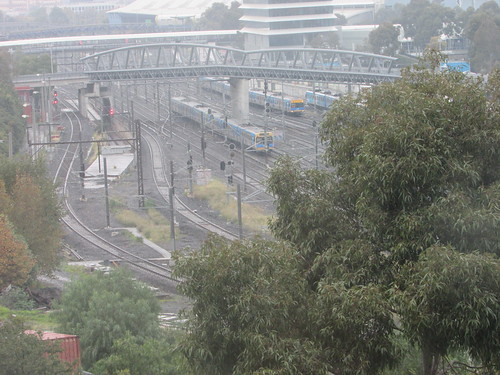
Melbourne: On a rainy morning, watching the trains go by.
I checked out a little before the arranged pick-up time of 10.30 a.m. and found the very professional driver to take me to the airport was already waiting outside with an immaculate Audi saloon. By this time, the rain had stopped and I had a very comfortable ride to Melbourne's Quantas Domestic Terminal where it was the usual do-it-yourself check-in.
The aircraft type was a Boeing 719 which I didn't think I'd flown before so not knowing quite where the seat I was allocated (23D) was, I left it unchanged - this proved to be a mistake.
The terminal was quite spacious without too many people travelling so, having browsed a few shops, I took a seat directly opposite the ramp where my aircraft was to arrive.
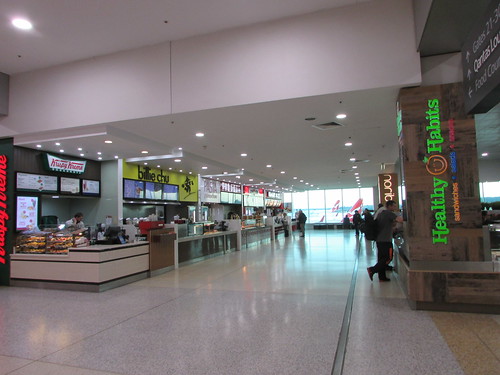
Melbourne Domestic Terminal: Lots of opportunities to spend money!
The inbound aircraft was delayed and frequent apologies were made over the public address. It was about 30 minutes late by the time it had shut down the engines and I amused myself taking pictures of all the different teams at work around the aircraft.

Boeing 717-200 operated by QuantasLink at Melbourne.
At last we boarded the Boeing 719 - a narrow-body, of course, but with it's two engines strapped to the fuselage rather than being wing-mounted. Seating in economy was 3+3 and, although row 23 had windows, the view was restricted by the engines. My row, row 24 only existed on the starboard side so my seat, 24D, was the aisle seat. The port side of the aircraft was completely obstructed with storage for catering equipment and there was no window on either side of the aircraft.
When 'Concorde' was designed, the passenger compartment originally had no windows - that solved an awful lot of engineering problems. But the response of people shown the 'mock-up' was so adverse that they decided to put windows in after all. I share that aversion to a lack of windows so I was quite uneasy on the flight which, fortunately, only lasted just over an hour.
Once I got off the plane in Hobart, I felt much happier. My driver met me in the crowded baggage hall but we had a few minutes to wait for the bags to arrive on the single baggage conveyor. A sniffer dog and his handler, having first checked the arriving passengers, jumped repeatedly on and off the conveyor (yes, both dog and handler) checking the bags as they appeared. Hobart was a much smaller airport and, having retrieved my bags, we only had a short walk to the car park and a waiting Mercedes saloon.
I think the journey into the city was about 18 km, on an uncrowded dual carriageway which passed through attractive, wooded hills. As we neared Hobart, we crossed the River Derwent on the impressive Tasman Bridge. This River Derwent is a broad estuary navigable by ocean-going ships, very unlike the Derbyshire River of the same name I'm familiar with.

Around Hobart: Approaching Hobart from the Airport.
Rather like Melbourne, but on a smaller scale, the city is a mixture of old and new buildings. The older English-style buildings, often 're-purposed', I found very appealing. We approached the harbour area, largely now a marina but retaining some working boats, and parked outside my hotel, which was formerly Henry Jones' extensive jam factory but is now an up-market hotel called 'The Henry Jones Art Hotel' (the hotel's website is here). Check-in at the hotel was friendly and I was soon in my first-floor room with views over the Victoria Dock.

View of Victoria Dock from the Henry Jones Art Hotel, Hobart.
In addition to being a hotel, it's an Arts Centre, based around the 'IXL Atrium', another part of the original jam factory. There are Studios, Galleries, various eating opportunities, shops and a bar. I didn't fully explore this interesting establishment as I'd promised myself a walk around the old dock area and the part of the town adjacent before it became dark.
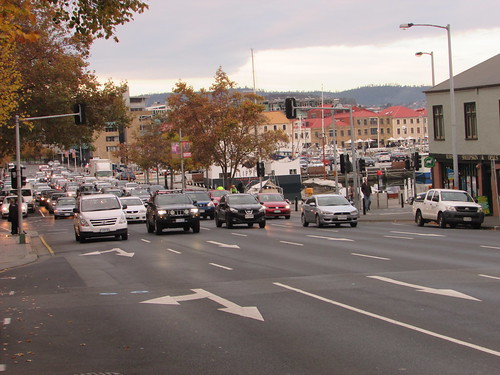
Hobart, Tasmania, with the Henry Jones Art Hotel visible in the background.
On my return, I had a snack and a drink at the Peacock and Jones restaurant before retiring to my room. I'm very taken with Hobart and the hotel, although both are a tad 'arty' for my taste. But it appears an excellent location to end my marathon trip.
Related Posts on this Website
Next Post describing this trip.
All Burma-2017 Trip posts.
All Australia-2017 posts.
My Pictures
Hotel Lindrum, Melbourne.
Melbourne's Local Railways (2006 and 2017).
Melbourne Airport.
Hobart, Tasmania.
The Henry Jones Art Hotel,
Hobart.
[Text amended, pictures added 8-Sep-2017]
Events of Tuesday 16th May 2017
After Myanmar's summer heat, it had been a shock to cross the equator and arrive in Perth in their autumn. Although I was warm enough in the day, each night as the temperature dropped I felt cold and needed an extra blanket on the bed. Melbourne was similar. My hotel room had Air Conditioning but my normal reaction is to turn it off, to prevent the noise from the fan disturbing me. However, without the Air Conditioning heating the room during the night, I'd needed an extra blanket for comfort but I slept well in the huge bed.
Having checked out the walking route from my hotel to Flinders Street Station the previous day and taken the precaution of purchasing the 'Myki' credit card-sized local transport ticket to use on Tuesday, readers will not be surprised that Tuesday turned into a 'Railway Day'. In addition to trying out the 'Metro' local trains, I wanted to travel on the Puffing Billy Railway - a substantial tourist railway in the hills to the east of the city. I knew from my previous visit back in 2006 that it was possible to reach the tourist railway by local electric train from Flinders Street, although on that occasion I was on a coach trip. This time, I was warned to allow at least 90 minutes for the journey travelling by rail.
I took breakfast in Hotel Lindrum's restaurant named, oddly, 'Felt' (Lindrum was a famous billiards player so the name refers to the green baize covering a billiard table).
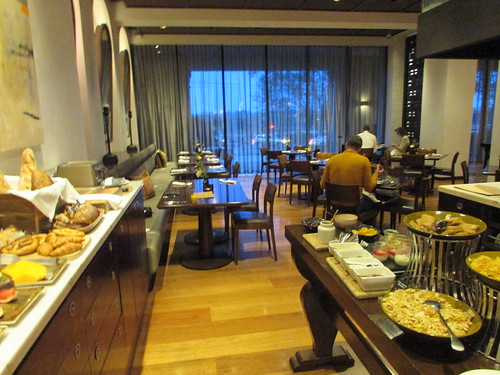
Hotel Lindrum, Melbourne: 'Felt' Restaurant.
I walked to Flinders Street Station in time to catch the 8.22 a.m. to Blackburn, with the intention of changing at Blackburn to a following train which went on to Belgrave.
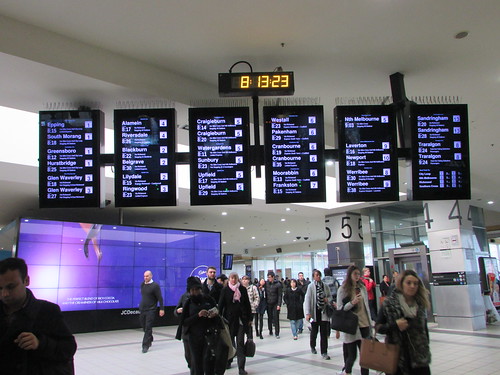
Melbourne to Belgrave: Concourse area at Flinders Street.
The 8.22 a.m. train was a few minutes late arriving at Blackburn and, by the time I'd worked out that I needed to go to a different platform at Blackburn to join the train onwards to Belgrave, I was in time to see it depart without me.
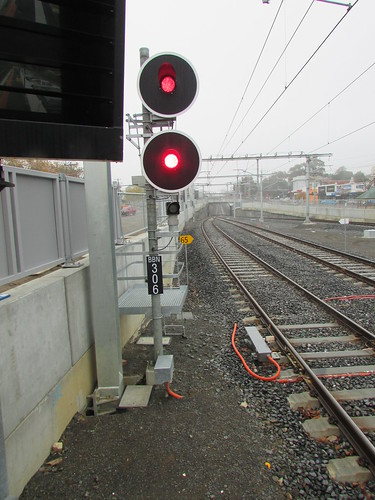
Melbourne to Belgrave: Blackburn, looking towards Belgrave, showing 'Victorian' pattern signal and train stop.
However, I successfully caught the next train to Belgrave and, on arrival at Belgrave, a footpath (identified with a painted, blue line) led me to the terminus of the Puffing Billy Railway.
The Puffing Billy Railway's website is here or, for more technical information, see the Wikipedia article here. On the day of my visit, trains were operating as far as Lakeside and I purchased a return ticket to travel to Lakeside on the first departure, the 10.30 a.m.
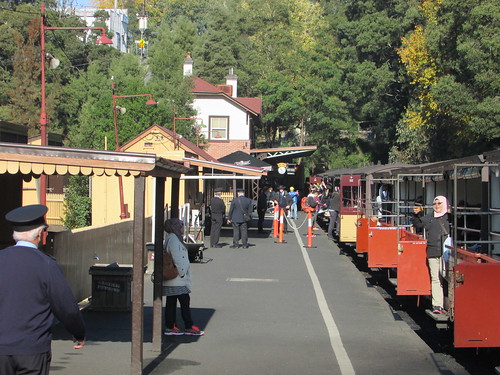 Puffing Billy Railway: Belgrave - Lakeside: Passengers boarding the 10.30 a.m. at Belgrave.
Puffing Billy Railway: Belgrave - Lakeside: Passengers boarding the 10.30 a.m. at Belgrave.
It's a charming railway, run mainly by friendly volunteers, but (with my background on British railways) I couldn't get used to the officially-approved seating position adopted by many of the passengers.

Puffing Billy Railway: Belgrave - Lakeside: I didn't try the officially-approved seating position adopted by many of the passengers.
The gradients require the narrow gauge 2-6-2 tank locomotives forming the majority of the motive power to work quite hard. The 10.30 a.m. was a long train and we were double-headed from Belgrave to Menzies Creek.
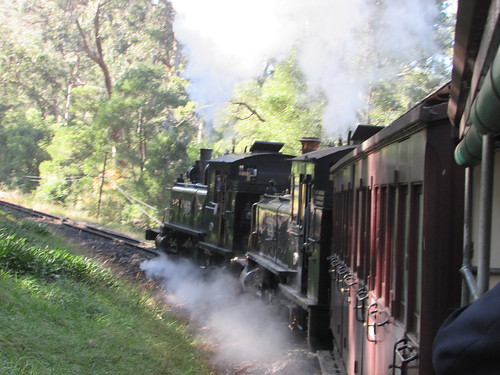
Puffing Billy Railway: Belgrave - Lakeside. The gradients require the narrow gauge 2-6-2 tank locomotives to work quite hard.
At Menzies Creek, the train divided and the pilot engine left us in order to work the detached coaches back to Belgrave to form a later train. We then continued to Lakeside where our engine took water and ran round the coaches, leaving the locomotive crew a short break before setting off back to Belgrave at 12.30 p.m.
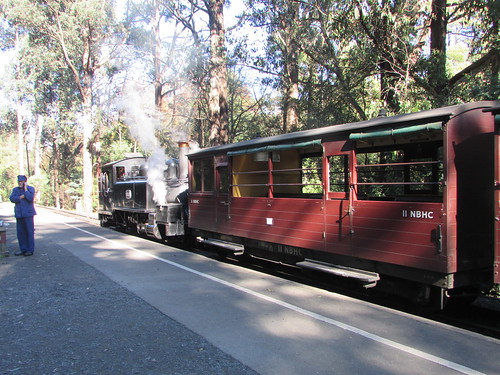
Puffing Billy Railway: Locomotive 14A ready to return from Lakeside.
I decided to return on the 12.30 p.m. train, continuing to take lots of pictures. In addition to the elegant and well-maintained steam locomotives, a feature of the line which particularly appealed to me was the semaphore signalling, much of it Mackenzie and Holland lattice posts.
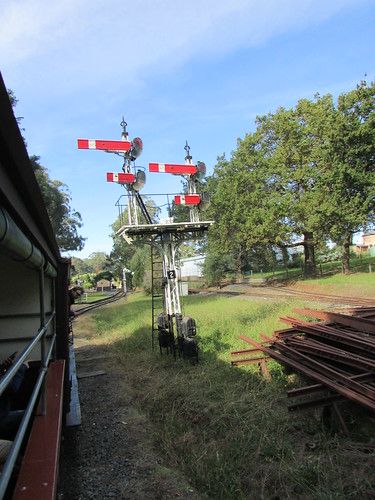
Puffing Billy Railway: Lakeside - Belgrave. Leaving Menzies Creek, showing a 4-arm bracket signal (motor operated).
I've no doubt I will produce a more technical report on this remarkable line in the future.
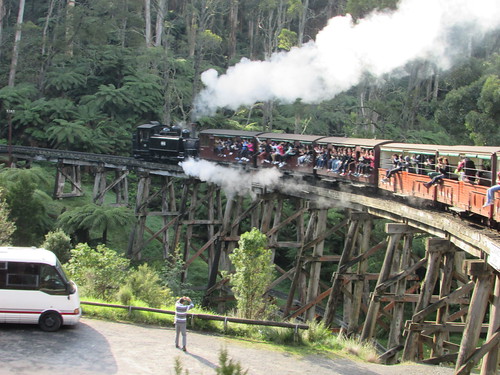 Puffing Billy Railway: Lakeside - Belgrave. Crossing the timber trestle bridge.
Puffing Billy Railway: Lakeside - Belgrave. Crossing the timber trestle bridge.
Back at Belgrave, I walked to the electrified broad gauge 'Metro' station and only had a few minutes to wait before the next train via Richmond to Flinders Street.
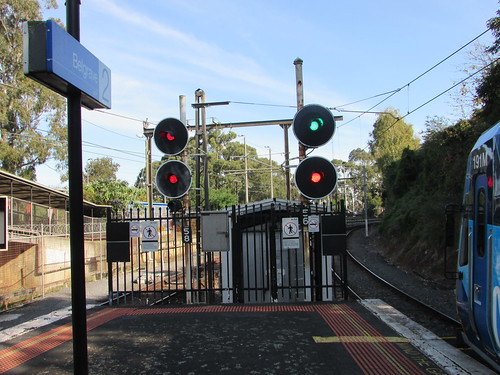
Belgrave station, with the train I caught to Melbourne on the right.
On arrival at Flinders Street, I decided to traverse the mainly underground 'City Loop', passing through the huge, modern Southern Cross station, followed by subterranean stations at Flagstaff, Melbourne Central and Parliament. Having reversed direction around the City Loop, the next station was Richmond (again), where I alighted. Richmond, with its ten platforms, seems to be Melbourne's 'Clapham Junction'.
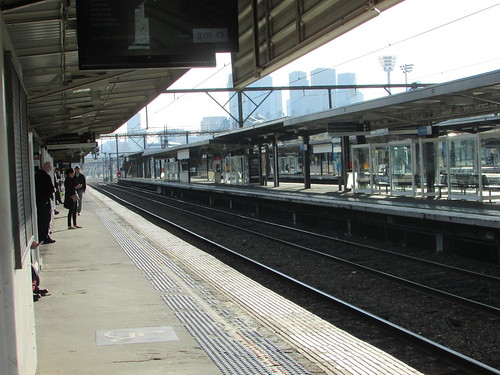
Richmond station, with Melbourne's skyscrapers in the background.
I crossed to Platform 1 for the next service back to Flinders Street which took around four minutes to reach the southernmost platform at Flinders Street, a bay. Exhausted by all this travelling, I walked back to my hotel and didn't venture out again, taking a dinner of soup and sorbet in my room whilst working on the computer and just watching the trains go by.
Related Posts on this Website
Next post describing this trip.
All Burma-2017 Trip posts.
All Australia-2017 posts.
My Pictures
Hotel Lindrum, Melbourne.
Melbourne (2006 and 2017).
Melbourne's Local Railways (2006 and 2017).
Puffing Billy Railway (2006).
Puffing Billy Railway: Belgrave - Lakeside (2017).
Puffing Billy Railway: Lakeside - Belgrave (2017).
[Text amended, pictures added 7-Sep-2017]
Events of Monday 15th May 2017
I was picked up a little after 8.00 a.m. on Monday to be taken to the domestic airport at Perth to catch a Quanta flight to Melbourne. I was sad to leave Keith, Fhines and Sasha behind.
I was travelling Economy and the large Check-in Hall was completely devoid of staff (except for a single Business Class check-in desk). So I thought I'd better attempt to use the Self-Check-In and Bag Drop which, rather to my surprise, I managed without incident.
With only minimal hand carried luggage, security was next. There were plenty of staff there and all were friendly and charming, improving my mood considerably.
At the Gate, the seating overlooked the Boeing 737-800 we were about to board and, on time, Quantas staff checked boarding passes and the passengers shuffled down the air bridge to the aircraft. The economy cabin had 3+3 seating and I did find it cramped but the cabin crew were welcoming.
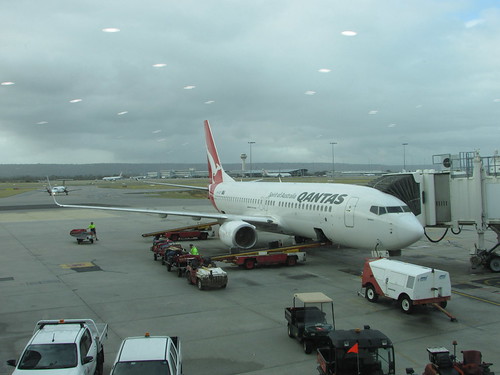
Perth Airport (Domestic): My Boeing 737-800 to Melbourne.
We took off promptly but there was a fair bit of turbulence as we climbed to cruising altitude. Once things had settled down, a meal was served. I had sausage and mash (in a cardboard box) but it was warm and tasty. As well as an orange juice, they followed up with tea or coffee (I had tea, of course) and later in the flight we had a frozen Snickers bar. We reached Melbourne in just over three hours. All in all, I found it a very satisfactory experience.
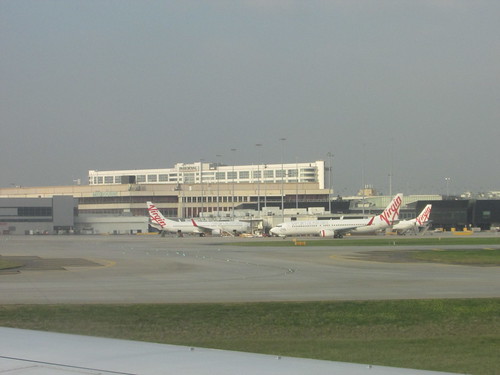
Melbourne Airport.
Because it was a domestic flight, the driver of my booked car was able to meet me in Baggage Reclaim - displaying my name on the screen of his mobile phone which looked very professional. We had a few minutes wait before baggage started to arrive at the carousel, but my two pieces appeared fairly early so we were soon driving into the city.
Although Melbourne has plenty of modern buildings and skyscrapers, many rather older buildings remain, giving the city an atmosphere which appealed to me, as it did on my first visit back in 2006. That first visit was part of a trip I call 'Round the World 3'. There's a very brief description in the post here but only the sections titled 'Saturday 18th' and 'Sunday 19th' talk about my expeiences in Melbourne.
This time, my travel agent had recommended the 'Hotel Lindrum', an old office building converted with a modern interior. My room on the third floor looked across the street to the complex network of railway lines entering Flinders Street Station, which pleased me greatly. All of the trains were Electric Multiple Units and the service was intensive - I discovered Melbourne's population is four and a half million and growing.
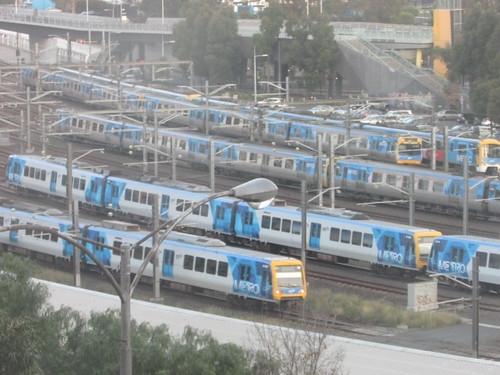
Melbourne's Railways (2017): The approaches to Flinders Street Station, viewed from my room at the Hotel Lindrum.
By the time I'd checked-in, it was late afternoon (Melbourne is two hours ahead of Perth) but I decided to take a short walk before it became dark. My route from the hotel took me along Flinders Street, parallel to the railway, towards Flinders Street railway station.
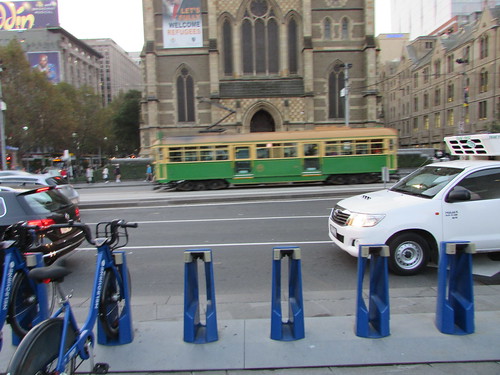
Melbourne: 'W' class heritage trams provide a free service around the city-centre Circle Line.

Melbourne: Flinders Street Station busy with commuters at 5.30 p.m.
I visited the tourist office, purchased a local transport ticket to use the following day, had a portion of chips in a station cafe and purchased a Coca Cola and Kit-Kat to take back to the hotel. It was dark by the time I was back at the hotel, so I worked in my room on the computer until bedtime.
Related Posts on this Website
Next Post describing this trip.
All Burma-2017 Trip posts.
All Australia-2017 posts.
My Pictures
Perth Airport (Domestic).
Melbourne Airport.
Melbourne (2006 and 2017).
Hotel Lindrum, Melbourne.
Melbourne's Local Railways (2006 and 2017).
[Text amended, pictures added 6-Sep-2017]
Events of Sunday 14th May 2017
Keith and I took Sasha for a longer walk on Sunday morning. The area where Keith lives is residential, with large, detached single-storey houses. Various areas of parkland (with all sorts of trees I didn't recognise) are scattered amoung the dwellings and the road system is supplemented by a network of footpaths, offering many alternative routes for walking.
After a leisurely breakfast, Keith and I discussed railways and engineering, as I studied some of Keith's extensive library of locomotive and railway books. We also looked at some of Keith's locomotive models - some proprietary, some built by Keith, including his live steam model based on L.B.S.C's 'Titch' design. Keith's model carries the nameplate 'ECCLES' (after 'The Goons' character - we were both fans of the radio show).

Keith's models: 'Eccles'.
In the afternoon, Keith, Fhines and I drove to visit another of their friends - Bill Fritchley. Bill had grown up in Myanmar and, before emigrating to Australia, had worked on steam locomotives for Burma Railways and served in the army. Needless to say, I quizzed him about his experiences on the footplate, particularly on the huge Beyer-Garratt locomotives.
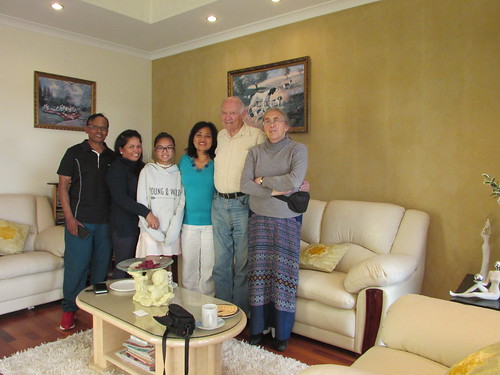
Perth: Bill Fritchley and Family, Fhines, Keith and Jan.
In the early evening, Keith, Fhines and I went by car to a nearby Singaporean restaurant for our farewell dinner. We had a sit-down meal but the restaurant also did take-away. Whilst we were there, numerous clients came in for take-away and the other tables started to fill up, testifying to the popularity of the place. We certainly enjoyed our meals.
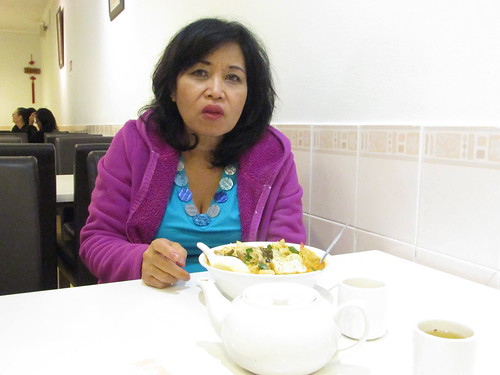
Perth: Fhines enjoying Singaporean cuisine.
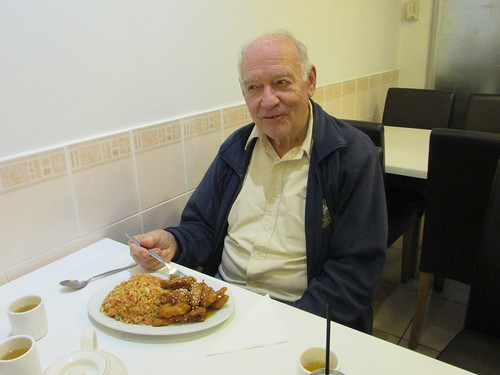
Perth: Keith enjoying Singaporean cuisine.
Back home, we had a relaxing evening watching television. I did a little work on the computer but I also had to contrive to compress all my possessions into one suitcase and one backpack (never an easy task) because I was being picked up at 8.00 a.m. the following morning to fly on to Melbourne, sad to leave Keith and Fhines who had made me so welcome.
Related Posts on this Website
Next Post describing this trip.
All Burma-2017 Trip posts.
All Australia-2017 posts.
My Pictures
Pictures from earlier trips.
Perth: Around and About (2017).
[Text amended, pictures added 6-Sep-2017]
Events of Saturday 13th May 2017
I was up in time to accompany Keith on a short walk with Sasha, Keith's dog. We left by car about 6.45 a.m. to drive to the home of Keith's friend, Birgit Gabriels. Occasionally on a Saturday, Keith and Birgit drive to the large Ikea store north of Perth for breakfast in the cafeteria, followed by a browse around the extensive showrooms.
I'd been invited to accompany them so, with Sasha and Birgit's dog Pepper left on guard duty in Birgit's house, we transferred to Birgit's car and drove towards the city, pausing to refuel the car. On a Saturday, we were able to make rapid progress and, after skirting the city centre, we continued north to Ikea and parked in the extensive ground level car park and went to the cafeteria where we each enjoyed an excellent, inexpensive breakfast including scrambled egg, bacon, sausage, tomato and a hash brown, accompanied by tea or coffee with free refills. Then, we spent some time touring the showrooms and Birgit made some purchases - the prices in Australia, like my own country, represent very good value.
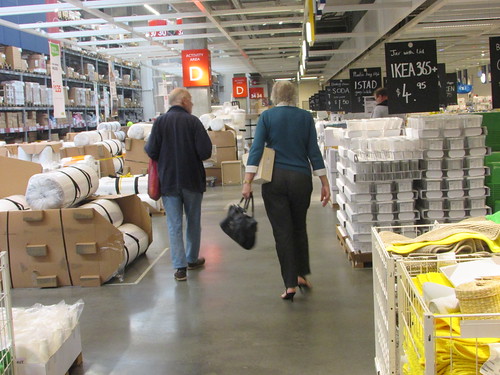
Perth: Around and About: Keith and Birgit shopping at IKEA.
Retrieving Birgit's car, we returned south, pausing at a large supermarket, a branch of Woolworth, where Birgit did a little shopping. I was impressed by the size of the 'Deli' counter and also by a small island counter selling Sushi, staffed by no fewer than six Sushi chefs.
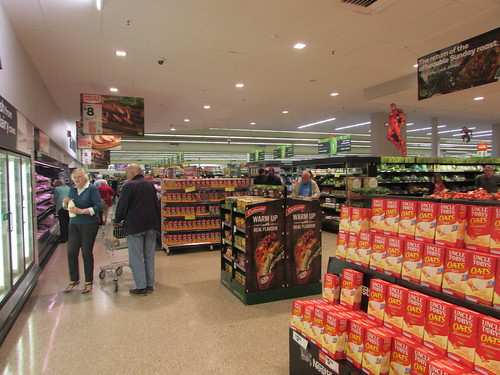
Perth: Around and About: Keith and Birgit shopping at Woolworths.
Shopping complete, we returned to Birgit's house and two very welcoming dogs where we chatted for some time in the elegant Dutch-themed house designed by Birgit's architect father. After a sandwich lunch with Birgit, Keith drove back to his home, detouring to visit another of Keith's friends, Annette. She was born in Australia but trained as a midwife in England, working in Wythenshawe (Manchester) and London's Harley Street before spells as a midwife in both Libya and Turkey.
In Australia, like America, you can make up your own car registration and Keith and I were amused by the registration 'ITZA MINE', attached to a beautifully-restored Ford Mustang.
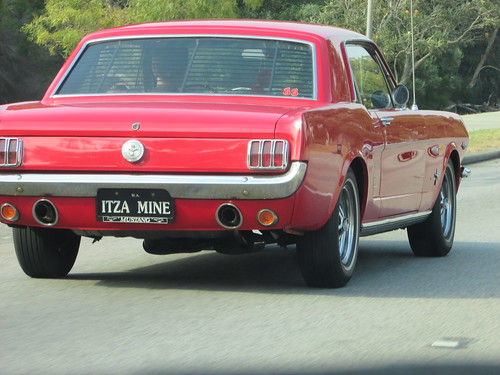
Perth: Around and About, Ford Mustang 'ITZA MINE'.
I'd arranged to meet my friend Captain Myo Lwin, whom I'd first met in 2008 as captain of the 'Road to Mandalay' river cruise ship in Myanmar. Having retired, he now divides his time between Perth, where he lives with his wife, daughter, son-in-law and grandson Wyatt, and Yangon. I was amazed at how Wyatt had grown since I last saw him.

Perth: Captain Myo Lwin, his Wife, Grandson and Jan.
After an enjoyable visit, Keith and I returned to Keith's home.
We spent a quiet evening in, watching television and talking. I dealt with e-mails, updated the blog and copied my photographs to my computer (in duplicate) until they could be uploaded to the internet.
Related Posts on this Website
Next Post describing this trip.
All Burma-2017 Trip posts.
All Australia-2017 posts.
My Pictures
Pictures from earlier trips.
Perth: Around and About (2017).
[Text amended, pictures added 6-Sep-2017]
Events of Friday 12th May 2017
I was up around 7.00 a.m. and accompanied my host, Keith Watson, on his walk to exercise his dog, Sasha, on nearby parkland. On our return, we had breakfast before getting ready to drive to see Birgit, a friend of Keith's for many years. On the way, we passed Bull Creek Station on Perth's excellent electrified suburban railway network. On previous visits, I've made use of this netwok.
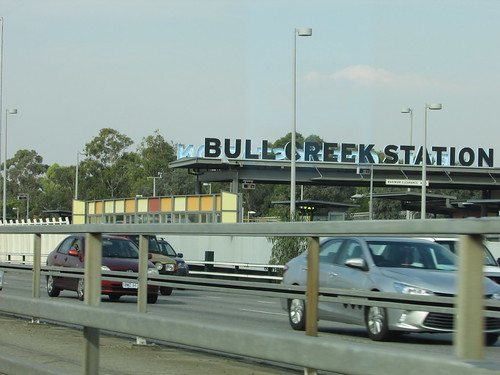
Railways around Perth: Bull Creek Station, Perth, Western Australia.
Sasha came with us in the car and played happily with Birgit's Manchester Terrier, Pepper.
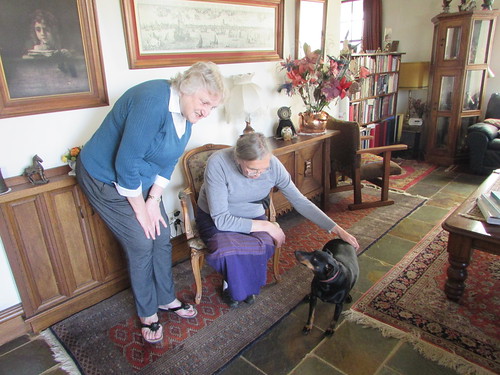
Perth: Birgit, Jan and Pepper.
After a pleasant visit, we returned to Keith's home. After some catching-up, Keith and I drove to a nearby 'Subway' where we purchased a filled baguette which we took home to consume. Later I attempted to connect my laptop to Keith's Wi-Fi, initially without success, but a call to Keith's computer man quickly resolved the problem and I was able to check my e-mails and post brief reports to my blog.
All the travelling had left me quite tired, so I didn't do much for the rest of the day. I was quite impressed by the television news coverage on SBS (the Special Broadcasting Service which is part of ABC - the Australian Broadcasting Commission), less so by the Eurovision Song Contest coverage from Ukraine.
I retired early and slept very well.
Related Posts on this Website
Next Post describing this trip.
All Burma-2017 Trip posts.
All Australia-2017 posts.
My Pictures
Pictures from earlier visits to Perth.
Perth: Around and About (2017).
[Text amended, pictures added 6-Sep-2017]
Events of Thursday 11th May 2017
That's Perth, Western Australia, not the one in Scotland.
I managed to pack, have breakfast and be ready for Doctor Hla Tun to take me to the airport. The Doctor's daughter and wife were with us in the car. The Doctor's daughter has just started medical studies at the college in Yangon so we dropped her at the campus before continuing to Mingalardon Airport Terminal 2. I said "Goodbye" to the Doctor and his wife helped me with my luggage to the right Check-in queue where we also said "Goodbye", as she had to open her Gift Shop in Terminal 2.
My travel agents, Wexas, had recommended flying by Jet Star to Singapore then Business Class by Quantas from Singapore to Perth. Both flights, confusingly were 'code share' with Emirates.
Waiting at the Gate, I had a good view of the Ground Crew preparing for the inbound flight, the aircraft arriving, unloading passengers and freight, refuelling and loading freight before I took my own seat on the aircraft. There's an album of pictures of these activities called Jetstar at Mingalardon.
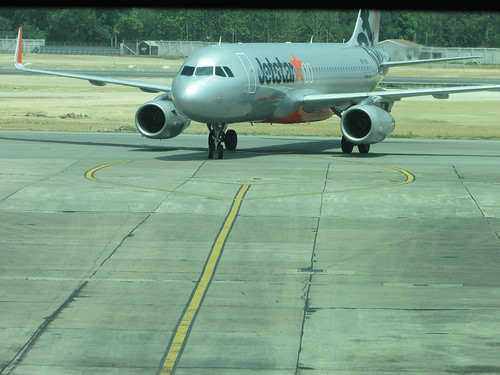
Jetstar at Mingalardon: The arriving A320 aircraft turns off the taxiway.
The Jet Star flight was all-economy (an A320 with 3+3 seating) and they charge for all food and drink separately. But, apparently, my name appeared on a special list and I received a free meal, a wash bag and the use of a blanket which proudly claimed it was made from '19 recycled plastic bottles'.
We arrived on time at Singapore's huge Changi Airport. Massive expansion work was being carried out in the terminal area and six tower cranes at work (painted in red and white stripes) dominated the biew as we taxied to our Gate.
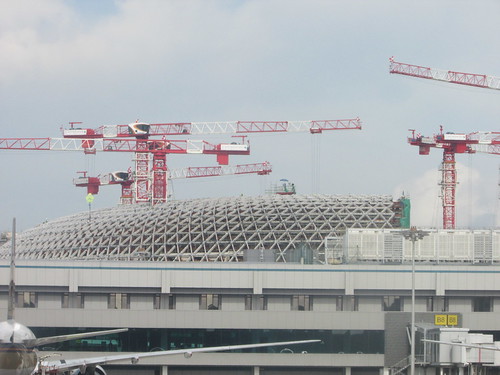
Changi Airport (2017): Six tower cranes working on expansion of the terminal.
The Transfer Desk issued my boarding card for my onward flight to Perth and I had a little over one and a half hours in the comfort of the excellent Quantas Lounge with time for a Coca Cola, Cheese Plate and internet fast enough to load a few pictures from Bagan.
The aircraft on the Perth leg was a Boeing 737. Despite the winglets to improve economy, the narrow body gives this iconic design a rather old-fashioned appearance.
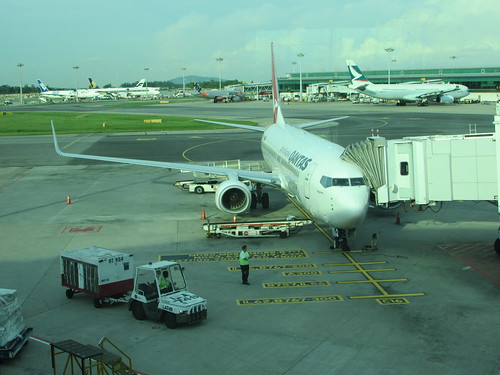
Changi Airport (2017): The 737 aircraft which would take me onward to Perth.
We taxied to the runway and, after one arrival and one departure had preceded us, we took off for the four and a half hour flight to Perth.
After a good flight, we landed a few minutes early at Perth. Immigration, Luggage Reclaim and Customs were completed promptly and the driver for my booked car was waiting in the arrival hall. Within a few minutes, we were on the way to my friend's house, arriving about twenty past midnight. After a joyful re-union with my friend Keith, his wife Fhines and, of course, Sasha the dog, I retired for the night.
Related Posts on this Website
Next Post Describing the Australian part of this trip.
All Burma-2017 Trip posts.
All Australia-2017 posts.
My Pictures
Yangon Airport (2010 and later).
Jetstar at Mingalardon.
Yangon -Singapore by air.
Singapore (Changi) Airport (2015 and later).
[Links to pictures added 16-Aug-2017: Text amended, pictures added 6-Sep-2017]
Events of Wednesday 10th May 2017
Since my first visit to Yangon in 2008, the intensive railway working around the Circle Line has fascinated me. There's an earlier post Yangon Area Railways which gives an overview.
My friend Doctor Hla Tun had managed (after some difficulty) to arrange official permission for us to visit signal cabins on the Circle Line before modernisation by the Japanese wipes them away. So the day was spent dashing from site to site in the Doctor's car and trying to understand the equipment and systems currently in use by inspection, by taking photographs for later study and by quizzing the local staff, with the Doctor as interpreter. We were warmly welcomed every where we visited and I had a wonderful day but, of course, ended up totally exhausted.
We first went to Khyee Myin Daing station I'd visited previously. There's an earlier post here. On the 'official' visit in 2017, I discovered signalling equipment in the Stationmaster's Office (of a pattern I'd not come across previously) which is used to instruct the two local signal boxes regarding the route through the station area to be taken by trains.
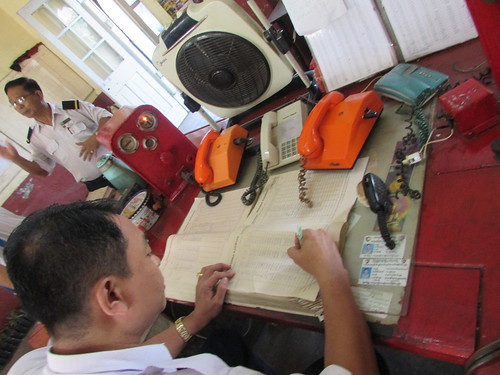
Kyee Myin Daing Station Master's Office, with the Station Master in the background. The red box on the left communicates the required route to the South Signal Cabin. There is a similar box to the North Signal Cabin. Note the grey auto telephone and two orange magneto telephones and two train register books.
Then we visited Kyee Myin Daing South Signal Box which I'd photographed a year earlier. This time, I was allowed to make three lever movements. I was very surprised when I learned, a few days later, that the stationmaster's photograph of the writer operating the frame had appeared in the newspaper Myanma Alinn Daily News on May 12.

Jan operating the lever frame at Khyee Myin Daing South Signal Cabin.
We then moved to Khyee Myin Daing North Signal Cabin for more pictures. The 'South' and 'North' cabins are the only 'mechanical' cabins in the Yangon area.
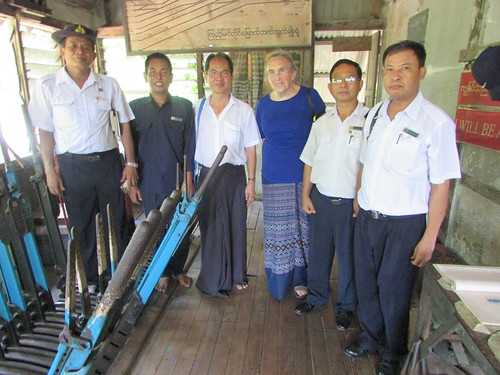
Kyee Myin Daing North Signal Cabin: The Group Shot.
On earlier visits to Insein, I'd identified the 'power' signal cabin but failed to identify the likely equipment supplier, so I was keen to inspect this installation. There's an earlier post here. On the 'official' visit in 2017, I discovered that the push-button control panel was a 'modified NX' pattern made in Korea. I was unable to inspect the relay room as the technician with the key was away at the time.
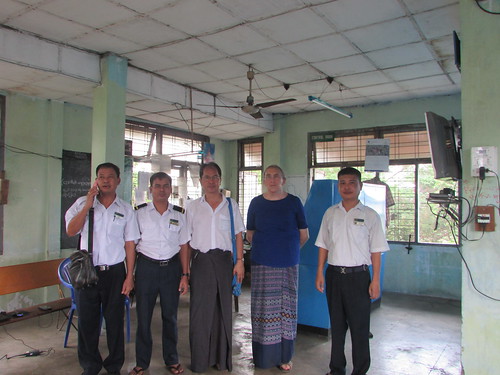
Insein Signal Cabin: The Group Shot. The blue signalling control console is in the background.
During a previous visit to Myanmar, I'd found a small push-button signalling panel at Da Nyn Gone which I believed had been built locally by Myanma Railways. There's a post here.
Based on this discovery, it appeared likely that the small installations at Mingalardon and Paywet Seik Kone were controlled from similar locally-built panels. The 'official' visit in 2017 allowed me to inspect both Mingalardon and Paywet Seik Kone stations and confirm that locally-manufactured push-button panels are in use.

Pa Ywet Seit Gone: Taking tea in the Station Master's Office.
I was also able to take pictures of the relay interlocking at the two sites and determine that rather elderly Westinghouse relays are in use.
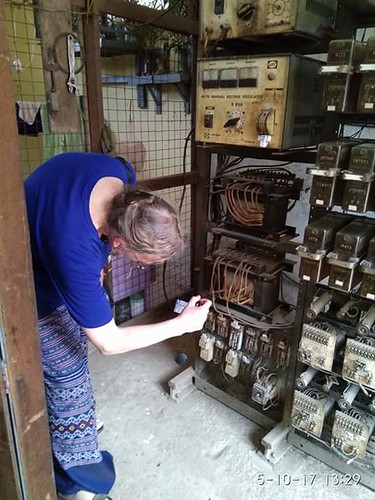
Jan examining Mingalardon signalling equipment (Photo: Myanma Railways)
I believe Pazundaung and Mahlwagone probably have similar installations constructed in Myanmar but there was insufficient time to establish this positively.
In the above, I've used the 'Anglicised' spelling which the railway seems to use, although rendering Myanmar names in 'English' is always a rather variable affair. I took lots of technical pictures, plus a few 'group shots' with the station masters and staff at some of the places we visited. These pictures have now been uploaded to 'Flickr' and the various new albums are listed below. It will take time to absorb what I saw and, in due course, further technical reports will surely appear.
I spent a quiet evening at Doctor Hla Tun's home. Sadly, I had come to the end of my visit to Myanmar and the following morning I was to travel to Australia to visit some of my friends there.
Related Posts on this Website
Next Post describing this trip.
All Burma-2017 Trip posts.
My Pictures
Kyee Myin Daing Station Master's Office.
Kyee Myin Daing South Signal Cabin (2017).
Kyee Myin Daing North Signal Cabin.
Insein Signal Cabin.
Mingalardon Signalling.
Pa Ywet Seit Gone Signalling.
[Text amended, links to pictures added 22-May-2017: Text amended, pictures added 5-Sep-2017]
Events of Tuesday 9th May 2017
I'd arranged with my guide, Ms. Thandar Oo, that I would take a trip around the lake by boat so, at 7.00 a.m., I breakfasted in the capacious restaurant at Villa Inle Resort and Spa and by 8.30 a.m. I'd checked out. Thandar Oo was waiting, this time with one of the elegant 15-metre Inle Boats.
With my luggage on board and sheeted over, we set of along the narrow canal between the hotel and Inle Lake, with the tomato 'fields' on both sides. The 'fields' are actually long and narrow floating strips of organic material laid side-by-side and each pinned to the lakebed with long bamboo poles. We passed local people at work tending the crop.
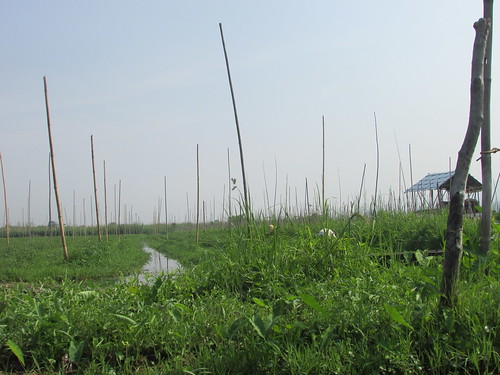
Around Inle Lake: Tomato growing.
In some places, zucchini were grown, under the same sort of bamboo frames I'd seen during our train journey from Kalaw to Nyaung Shwe.
Once we entered the broad expanse of the Lake, there were numerous Inle boats, similar to our own, noisily heading in all directions. Usually, the motive power is a manual-start, Chinese-made diesel developing 25 horse power costing 500 U.S.dollars new and perhaps 300 U.S. Dollars second-hand. Later in the day I spotted a few Inle boats powered by an automotive engine which was probably more powerful. It was certainly quieter! Some of the smaller boats on the water were of the well-known 'longtail' design and yet others were not motorised at all.
Harvesting Weed
Inle Lake is quite shallow and water weed grows freely. One of the more arduous tasks is collecting water weed from boats, using a long pole to repeatedly lift massive clumps of weed into the boat until it almost sinks. The weed is then dried and used as fertiliser for the tomatoes.

Around Inle Lake: Collecting water weed as fertiliser.
Inle Lake Villages
I was told that there are seventeen distinct villages distributed around the lake, with a total population of around 56,000, plus a further 40,000 people at Nyaung Shwe which serves as the administrative centre of the area.
A broad canal led us to a large village of substantial houses on stilts, raised high above the water. Although some designs recurred frequently, each building reflected the owner's tastes in decor. Some houses were completely made of bamboo but most partially adopted more modern building techniques.
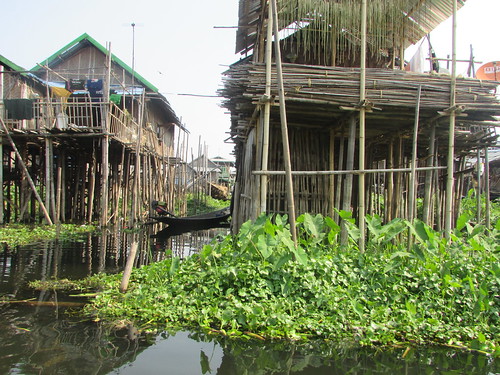
Around Inle Lake: Traditional, bamboo stilt houses.
Piped water (via blue HDPE pipes) and electricity (via a most curious distribution system featuring wooden pylons along all the main canals) were commonplace.
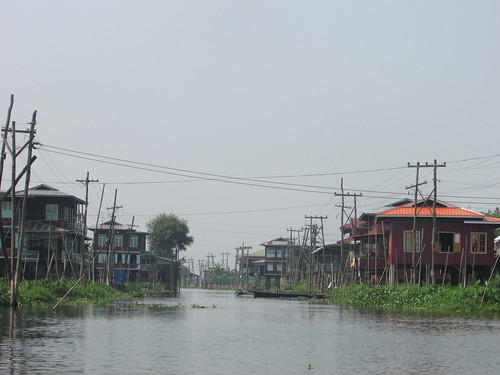
Around Inle Lake: Typical village with its curious electrical distribution system.
The village included a long, open shed housing one of the equally-long man-powered racing boats which compete during the Pagoda Festival. Narrower canals, with a number of footbridges, led us to the rickety wooden landing stage of a family-run silversmith's workshop.
Silversmith's Workshop
Silver ore is reduced to pure metal in a small, clay crucible. This requires a temperature of 800 degrees Celsius produced in a small forge using bellows to supply extra air. The molten silver is cast into a small ingot using a simple mould and, after cooling in cold water, the ingot can be beaten to the required thickness or turned into silver wire using a small 'mangle'. The hard fruit of the Star Anise plant, if warmed for one minute can be grated to give an effective 'soap' for silver cleaning, for clothes washing without fading dyes or as a shampoo. There was a large showroom with an amazing range of silver jewellery. The delicacy of some of the items was astonishing.
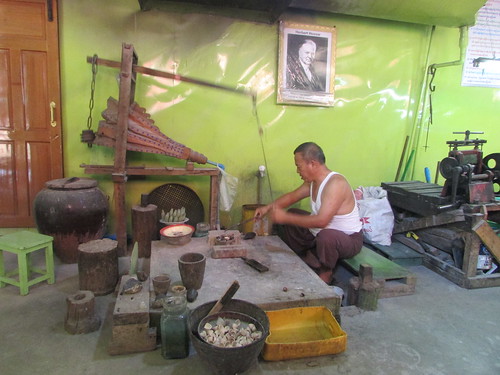
Inle Lake Silversmith: General view of silver smelting workshop.
Boat-building yard
Our next visit was to a boat-building yard. Two 15-metre long hulls of the standard Inle design were virtually complete and I was staggered by the craftsmanship. Only teak wood is used and, when we arrived at the landing stage, two men were starting to turn one two-inch thick teak plank into two one-inch thick planks by sawing. One man stood on a raised sawing platform made of bamboo, one man stood on the ground and between them a massive saw was being worked vertically up and down.

Inle Lake Boat Builder and Cheroot Factory: Sawing a teak plank.
Each of the many frame members required was made from three pieces - left, keel, and right.The keel itself is normally made from three planks to give a slightly convex shape, requiring keel frame members to be curved at the bottom. Keel frame members were being shaped, with considerable accuracy, by another man sitting on the ground merely using an axe.
The structure of the hull had been assembled using wooden dowels, but I didn't identify the wood. Metal woodscrews were used for some features, like attaching the planks forming the top of the gunwhales.
All seams, dowels and screwheads had been caulked using teak sawdust and resin mixed in a simple stone mortar with a pestle to give a dark-coloured paste. Boats built in this traditional way have a long life of tens of years given some maintenance. The purchase cost of 2,500 U.S. Dollars seemed very reasonable to me given the skill and man-hours involved in the construction.

Inle Lake Boat Builder and Cheroot Factory: Completed hull.
Cheroot Factory
Immediately behind the boat-building yatd was a cheroot-making factory. Home-made cheroots can be huge, fat affairs but the commercially-made cheroot is more like the small cigars marketed as 'cigarillo'. Seated on the floor of the factory, a number of women, paid by 'piecework' were deftly assembling the product. According to a sign in English for the benefit of the many tourists around Inle Lake, the ingredients are:-
Cheroot Leaf
Tobacco
Honey
Tamarind
Brown Sugar
Rice Wine
Banana Fruit
Star Anise
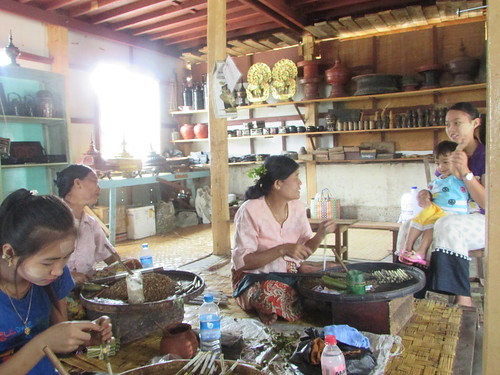
Inle Lake Cheroot Factory.
Alodawpauk Pagoda
A boat ride of less than 200 yards took us to one of the landing stages of the important Alodawpauk Pagoda. This was busy with tourists, many apparently from Mynmar. I was told it's an 11th century pagoda which, because of its importance, was restored by the military government in the 1980s. Ongoing development is paid for by private and business donors, some in Thailand.
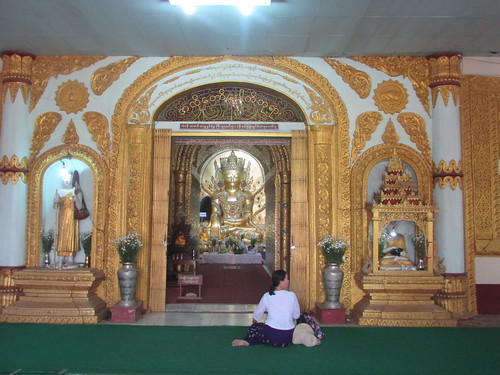
Alodawpauk Pagoda, Inle: One of the four main Buddha images.
Blacksmith's Factory
After a brief visit to a bamboo handicrafts showroom where modern products for tourists seemed to predominate, we moved on to a blacksmith's workshop. As the boat docked at the usual rickety landing stage, I was sure I recognised it and, indeed, it was the same blacksmith's I'd visited in 2008. That first visit is described in another post called 'Around Lake Inle' which you can find here. Work was being carried on exactly as I'd witnessed the first time, but the personnel had changed.

Inle Lake Blacksmith.
After the blade forging process, sharpening was being carried out by two men, one using a sort of spokeshave to scrape away excess metal, the other using an assortment of metal files to produce the cutting edge. Both men used simple jigs to hold the workpiece but the man with the files also used one foot, like a third hand, to hold the item in the jig.
Impressed with the skills, I determined to purchase a souvenir. I came away with a pair of scissors which I intended to display at home but they proved so sharp they're in daily use in my kitchen.
Lunch
After visiting the blacksmith's workshop, a short boat ride took us to the huge, clean 'Golden Kite Restaurant' built, like the rest of the village, on numerous wooden piles but here the landing stage was, unusually, in good repair. The restaurant was located at the intersection of two major canals so it was rather noisy but we nonetheless enjoyed lunch there.
 The 'Golden Kite Restaurant'.
The 'Golden Kite Restaurant'.
Return to Nyaung Shwe
Back in our boat, it was time to head back north to Nyaung Shwe. This took about 45 minutes, very pleasant but noisy.
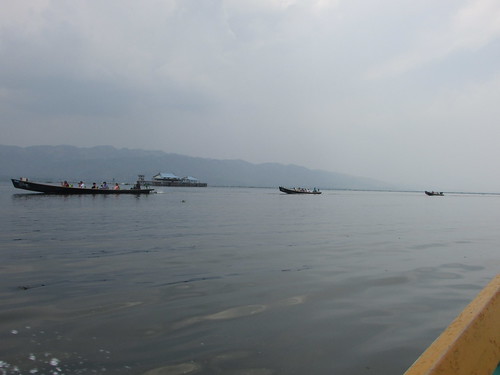
Return to Nyaung Shwe: Speeding north, passing three similar boats heading south.
On arrival at Nyaung Shwe, our driver was waiting to meet us and my luggage was soon transferred to the car. We set of towards Heho for me to catch the afternoon Air KBZ flight back to Yangon. At Shwe Naung, we turned left towards Heho.
Paper making
"We're a little early", Thandar Oo said, telling the driver to stop at a small paper handicrafts workshop up in the hills. We watched two women making sheets of paper from the bark of the Mulberry tree. I'd seen a similar process, but using different plant material, in Bhutan and that's described here. In Myanmar, the mulberry bark is softened with hot water and then pounded with hammers until it becomes a paste which, mixed with water, can be poured onto a muslin-covered wooden frame in a cistern of water. Then, if desired, decoration can be added, creating patterns with leaves and petals before the frame is gently lifted from the water and allowed to drain, leaving a layer of cellulose material which, when dried in the sun, will become paper. A wide selection of products made from this paper were on display.
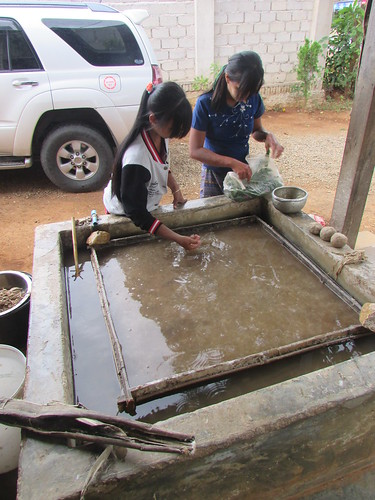
Nyaung Shwe - Heho: Paper handicraft workshop - decorating the paper with leaves and petals.
Heho Railway Station
We set off again, still early, so I proposed a visit to Heho station. I was able to take a number of photographs and, using Thandar Oo as an interpreter, clarify various technical points with the friendly young stationmaster.
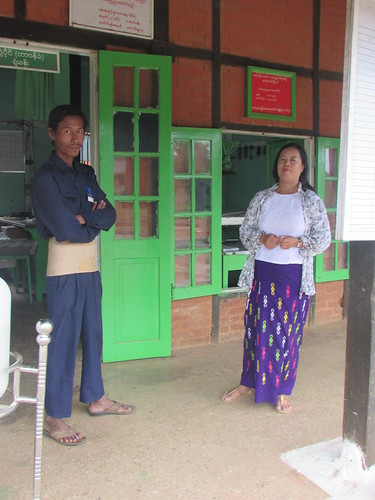
Heho Station: Left - the Stationmaster, right - my Guide Thandar Oo.
Return to Yangon
Heho airport was only a few minutes away and on arrival it was time to say "Goodbye" to my driver and guide. Since it was 'low season', I was surprised at how many tourists were waiting to travel - Japanese, German and various English-speaking travellers. The Air KBZ flight was on time into Yangon where two transfer buses took us to the new Domestic terminal. Doctor Hla Tun was waiting to pick me up, as I was again staying at his home.
Related Posts on this Website
Next Report describing this trip.
All Burma-2017 Trip posts.
My Pictures
Around Inle Lake (2017).
Inle Lake Silversmith.
Inle Lake Boat Builder and Cheroot Factory.
Alodawpauk Pagoda, Inle.
Inle Lake Blacksmith (2017).
Naung Shwe - Heho by road.
Heho Station.
[Links to pictures added 16-Aug-2017: Text amended, pictures added 4-Sep-2017]























































